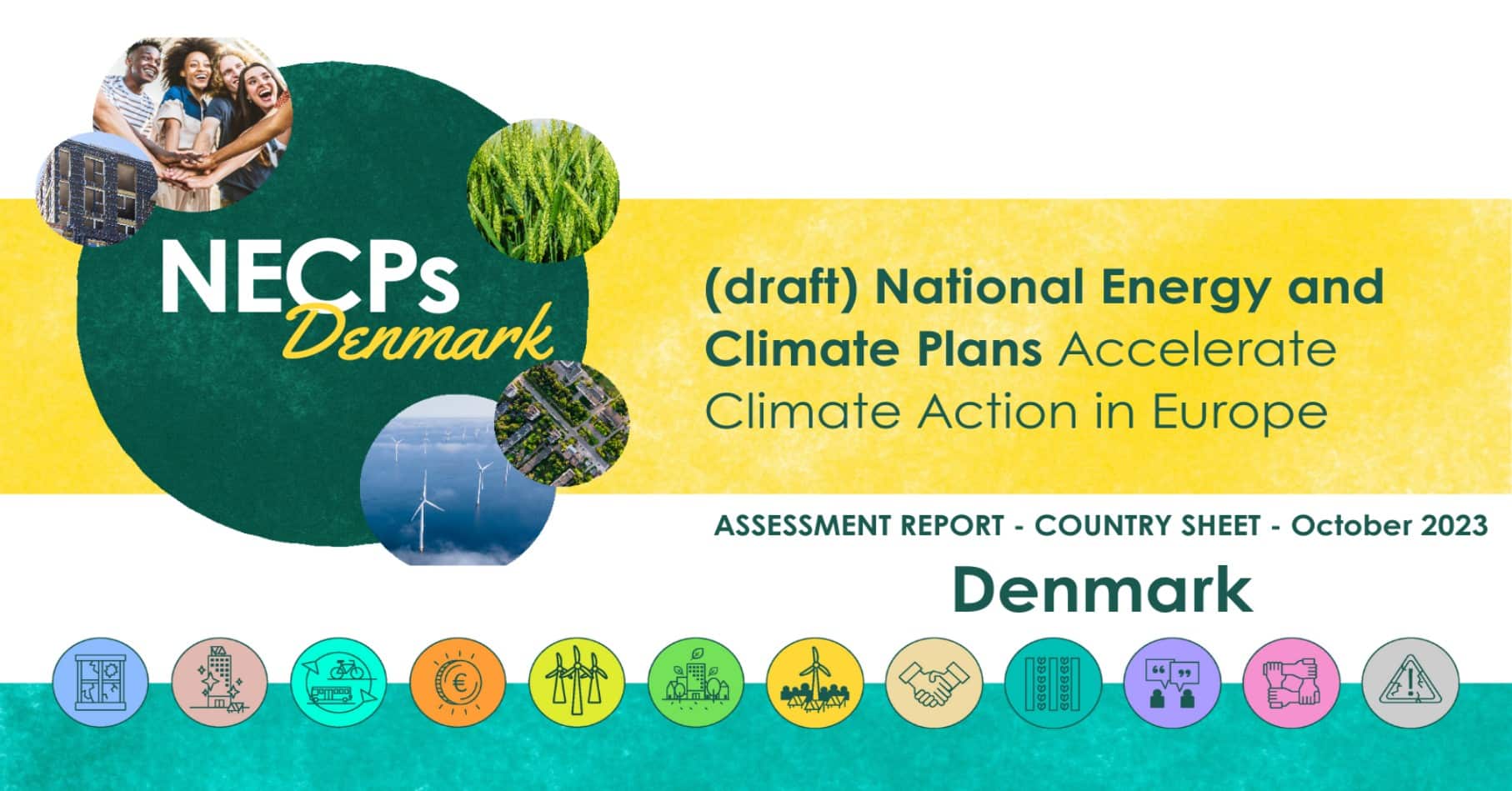The Danish draft National Energy and Climate Plan (NECP) update was submitted only a few days after the deadline. This assessment is based on the text available on the Danish government website. Denmark’s draft NECP update fails to align with a 1.5°C compatible trajectory. It does not present an improved 2030 climate economy-wide target and it fails to meet the minimum EU requirements for climate effort-sharing and LULUCF. As no additional measures are provided, it fails to illustrate how it will bridge the gap to reach its 2030 targets. Projections show Denmark would surpasses the minimum EU requirement for renewables. The draft NECP fails to align with the 2030 EU energy efficiency target. On top, meaningful stakeholder engagement was not ensured. Denmark ultimately undermines the Governance Regulation, as the NECP draft update does not increase its ambition.
RECOMMENDATIONS
- Immediately start preparing a NECP draft with increased ambition. The current draft NECP update is only a frozen policy scenario;
- Include additional policies and measures in the new plan, in line with improved ambition;
- Together with stakeholders, develop several scenarios for additional measures that are sufficient to ensure that Denmark’s final NECP update as a minimum provides a plan to fulfil Denmark’s 2030 reduction targets, both nationally and towards the EU.
Climate Ambition
Climate targets have not increased since 2019. The draft repeats the economy-wide target from the 2019 NECP: 70% emissions reduction by 2030 (compared to 1990 levels). This implies that the increase that occurred in EU-wide climate ambition since 2019 is not reflected in the draft.
Denmark’s draft contains a projection with existing measures but it does not contain any additional PAMs nor any projections with additional measures. Under the projections with existing measures, Denmark will fail to meet both its national targets and its EU obligations. It will notably fall short of its national economy-wide 2030-target of 70%. At the EU level, it will fall short of both its Land Use, Land-use Change and Forestry (LULUCF) and Effort Sharing Regulation (ESR) targets – respectively of -9.7 and -15.8 MT CO2-eq over the period 2021-2030. Denmark must therefore plan more additional measures, and develop scenarios that include them (proposals for scenarios available here).
Energy Transition
Denmark expects to reach a renewable energy share of 71% by 2030, which will surpass the Governance Regulation formula benchmark to reach the binding EU 2030 renewable energy share of 42.5%. However, the plan relies heavily on unsustainable volumes of imported wood biomass until and beyond 2030. It is not possible to assess PAMs for renewables, as the draft only includes the scenario with existing measures and no additional measures are presented.
Denmark fails to provide details on its energy efficiency plans. It does not indicate an energy efficiency contribution in its draft NECPs update. Denmark’s national contribution should surpass the minimum reduction of energy consumption as per formula benchmark of the 2023 Energy Efficiency Directive (EED) in line with the EU energy efficiency target. Denmark’s contribution should be at a minimum no higher than 15.52 Mtoe for primary energy consumption and 13.73 Mtoe for final energy consumption. The draft indicates that Denmark will update its national contribution, planned policies, measures and programmes in June 2024. With only existing energy efficiency measures listed in the draft, additional measures are needed to fulfil the 2030 EU energy efficiency target.
FOSSIL FUELS ALERT
- Fossil gas – The draft presents no plans to decommission fossil gas infrastructure. Instead it includes in its energy planning three recent or about to be inaugurated projects that could triple fossil gas availability between 2022 and 2030. This is in sharp contrast not only with EU climate objectives, but also with the recently adopted fossil gas targets, which are not correctly reflected in the draft.
FALSE SOLUTIONS ALERT
- Like the 2019 NECP, the draft bets that CCS/CCU will capture 3.2Mt CO2 by 2030. 5 billion euros have been allocated. At present, only one CCS project has been approved, which only aims to capture 0.45 Mt and will not be operational before 2025.
- Biomass now accounts for 29% of Denmark’s total energy use, which is projected to remain after 2030. Such volumes are unsustainable – as shown also by the decline in the forest carbon sinks. Denmark should plan to rely less on biomass and phase out its annual DKK 5.8 billion biomass subsidies.
IS MONEY WHERE THE MOUTH IS?
- As the draft contains no additional measures, no additional funding is required. The section on investments only outlines the costs of PAMs since 2019, which are already financed.
- The draft does not mention which additional measures were financed by RRF and REPowerEU funding. This is because there was none: Denmark has not included any additional PAMs as a result of receiving this additional money; rather, EU funds were used for PAMs already funded by the state budget.
SNEAKY SUBSIDIES
- The draft claims that no subsidies for fossil fuel use exist. However, Denmark subsidises fossil gas use by spending its earnings from the Baltic Pipe to reduce the domestic gas tariffs.
- Denmark spends DKK 5.8 billion annually to subsidise biomass. This is harmful for Denmark’s energy transition, as biomass competes with wind and solar, slowing down their development.
PUBLIC PARTICIPATION
- Early and effective involvement of stakeholders was not ensured and no platform for multilevel dialogue was created. The quality of the involvement was ineffective, and inputs resulted in no substantial changes in the content of the draft.
- The lack of projections with additional measures – which the Governance Regulation clarifies should be a key point for stakeholders and public engagement – undermined the purpose, effectiveness and quality of public consultations.
Download denmark country sheet NECP assessment report
Download FULL NECP assessment report
PREVIOUS
NEXT

